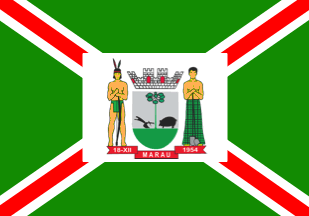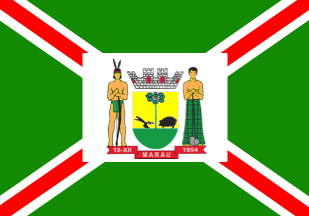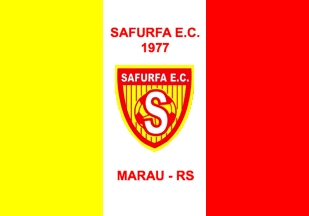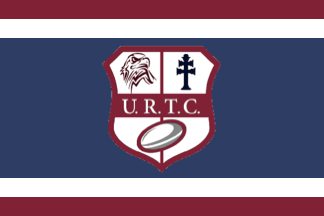 image by Ivan Sache, 31 July 2020
image by Ivan Sache, 31 July 2020
Last modified: 2020-07-31 by ian macdonald
Keywords: rio grande do sul | marau |
Links: FOTW homepage |
search |
disclaimer and copyright |
write us |
mirrors
 image by Ivan Sache, 31 July 2020
image by Ivan Sache, 31 July 2020
The municipality of Marau (44,161 inhabitants in 2019; 64,930 ha) is located
265 km north-west of Porto Alegre.
Marau was settled in 1904 by Italian
colonists and elevated to the 5th district of Passo Fundo on 10 January 1916,
with its seat at Tope. The capital of the district was transferred to Marau on 3
July 1920.
Borella was established in 1923, soon to be a regional and
national reference for pork meat products. Salami became Marau's iconic product.
The municipality of Marau was established in 18 December 1954 and inaugurated on
28 February 1955.
http://www.pmmarau.com.br
Municipal website
Ivan Sache, 31 July 2020
The flag and arms of Marau are prescribed by Municipal Law No. 675 promulgated
on 4 December 1974.
Article 6.
The municipal flag of Marau, designed
by the heraldist Arcinoé Antonio Peixoto de Faria, shall be quartered by a
saltire, with green quarters formed by white stripes of two units in width
superimposed with red stripes of one unit, arranged in bend and bend sinister
and crossing in the flag's center, where their are superimposed by a white
rectangle of six units in width on eight units in length charged with the
municipal coat of arms.
§1. In compliance with the Portuguese and
heraldic traditions, and their inherited canons and rules, municipal flags have
to be divided in eight, six, four or three quarters, featuring the same colors
as the coat of arms and in the center or at hoist a geometrical figure
inscribing the municipal coat of arms.
§2. The municipal flag of Marau obeys
this general rule, being quartered by a saltire. The coat of arms applied on the
flag represents the municipal government while the white rectangle represents
the town as the municipal seat. White is a symbol of peace, friendship, work,
prosperity and religious feeling. The white stripes charged with red stripes
quartering the flag represent the spread of municipal power all over the
territory. Red is a symbol of dedication, patriotic love, audacity, intrepidity,
courage and valiance, while the green quarters represent the rural estates
scattered over the municipal territory. Green is a symbol of honor, civility,
courtesy, glee and abundance; green also symbolizes hope as greening fields in
spring promising profuse harvests.
Article 7.
In compliance with
heraldic rules, the municipal flag shall have the official dimensions adopted
for the national flag, 14 units in width on 20 units in length.
Article
19.
The coat of arms of Marau, designed by Valter Spaldinn and revised by the
heraldist Arcinoé Antonio Peixoto de Faria, is described as follows:
A
classical Flemish-Iberian shield surmounted by a six-towered mural crown argent
ports gules, on a field argent issuant from a base vert a stylized Brazilian
pine of the same surrounded dexter by a plow and sinister by a pig passant all
sable. The shield supported dexter by a stylized Indian proper clad with a
string vert and holding a bow and arrow sable and sinister by a colonist proper
clad with trousers vert. Beneath the shield a scroll gules inscribed in letters
argent the toponym "MARAU" surrounded by date "18/XII/ 1954".
The coat of
arms has the following symbolic interpretation:
a) The classical
Flemish-Iberian shield, used to represent the arms of Marau, also known as
"Portuguese shield" because it was generalized in the kingdom, was inherited by
Brazilian heraldry to evoke the colonizing race and main builder of the nation.
b) The mural crown surmounting the shield is the universal symbol of coat of
arms of domains; argent (silver) with six towers, four visible in perspective,
it classifies the town as of third rank or municipal seat. The port gules (red)
represent the proper qualities of the leaders of the community.
c) Argent
(silver) is a symbol of peace, friendship, work, prosperity and religious
feeling.
d) The Brazilian pine vert (green) issuing from a base of the same
evokes a feature of the whole southern region of Brazil, constituting a natural
resource for the municipality.
e) Vert (green) is a symbol of honor,
civility, courtesy, glee, abundance; green also represents hope as the greening
fields in spring promising profuse harvests.
f) The plow and the pig sable
(black), recall the main sources of income for the municipality, agriculture and
pig-breeding.
g) Sable is a symbol of austerity, prudence, wisdom, moderation
and firmness.
h) The outer ornaments, the supporters represented by a Marau
Indian dexter and a colonist sinister, recall the human components of the early
colonization: the grant of land by the tribe whose name was immortalized in the
municipality's name and the conquering colonist who civilized and offered
prosperity to the community.
i) On a scroll gules (red), a symbol of
dedication, patriotic love, audacity, intrepidity, courage, and valiance, is
inscribed the identifying toponym "MARAU" surrounded by the date of political
emancipation, "18-XII-1954".
https://leismunicipais.com.br/a/rs/m/marau/lei-ordinaria/1974/68/675/lei-ordinaria-n-675-1974-dispoe-sobre-a-forma-e-apresentacao-dos-simbolos-do-municipio-de-marau-e-da-outras-providencias
Leis Municipais database
The first coat of arms of Marau was
prescribed by Law No. 472 promulgated on 1 July 1969.
Article 1.
A
Portuguese shield, tierced in mantel or, argent and vert, with a stylized
Brazilian pine proper dividing the shield. On the field vert, with a Brazilian
pine issuing from its center, a plow argent dexter and a pig passant sinister. A
three-towered mural crown. A scroll azure charged with the black writing
"18-XII-Marau-1954", the date of municipal emancipation. The shield supported
sinister by a colonist and dexter by an Marau Indian, the municipality's
namesake, holding a bow and arrow. The association of the national and
Riograndense colors, also represents sinister, via the field or, the resources
of the municipality, agriculture, commerce, industry and the people's firmness;
sinister, via the field argent, the quality of the air, of the weather and of
the people and the purity of the feelings; in base, the fields and forests of
the municipality and constant aspiration to greatness of the land for the
greatness of Rio Grande do Sul and Brazil; the stylized Brazilian pine, proper,
representing the primary plant resource of the region; the plow argent, as a
symbol of field work, source of income for the municipality; the pig or,
representing pig-breeding as the other source of income for the municipality,
the three-towered crown or representing a town born from a modest settlement and
today a progressive and active town; the blue scroll, the sky and the worker's
virtue and cooperation at work; the municipality's date and name in black,
representing people's tenacity. The supporters are a tribute to the colonists,
architects of the municipality's wealth, and to the struggle against the Marau
Indians for the conquest of the land, its settlements and culture.
http://www.pmmarau.com.br/conheca-marau/brasao?template=pmmarau76
Municipal website
Photos
https://www.facebook.com/PrefeituraMarau/photos/a.2196384037254532/2716864218539842/?type=3&theater
https://www.facebook.com/PrefeituraMarau/photos/a.2736855529874044/2736866263206304/?type=3&theater
http://www.pmmarau.com.br/noticias-geral/645-definida-a-programacao-da-semana-da-patria-em-marau
https://www.facebook.com/PrefeituraMarau/photos/a.2696068653952732/2696069257286005/?type=3&theater
https://www.facebook.com/PrefeituraMarau/photos/a.2454236388135961/2455150424711224/?type=3&theater
https://www.facebook.com/prefeituradeMatoCastelhano/photos/a.623602151022438/835887843127200/?type=3&theater
Ivan Sache, 31 July 2020
 image by Ivan Sache, 31 July 2020
image by Ivan Sache, 31 July 2020
A
small-sized flag has the field of the coat of arms or instead of argent -
probably a reminiscence of the former coat of arms.
Photo
https://www.facebook.com/PrefeituraMarau/photos/a.2882062822019980/2882064065353189/?type=3&theater
Ivan Sache, 31 July 2020
 image by Ivan Sache, 31 July 2020
image by Ivan Sache, 31 July 2020
The flag of Safurfa F.C is vertically divided yellow-white-red with the club's
emblem in the white star, surrounded by "SAFURFA E.C. / 1977" (top) and "MARAU -
RS" (bottom), all in red.
Photos
https://www.facebook.com/PrefeituraMarau/photos/a.2882062822019980/2882064065353189/?type=3&theater
https://www.facebook.com/PrefeituraMarau/photos/a.2736855529874044/2736866543206276/?type=3&theater
https://www.facebook.com/PrefeituraMarau/photos/a.2454236388135961/2454260744800192/?type=3&theater
Ivan Sache, 31 July 2020
 image by Ivan Sache, 31 July 2020
image by Ivan Sache, 31 July 2020
The flag of U.R.T.C. is blue with two horizontal purple and white stripes at the
top and at the bottom and the club's emblem in the center.
Photo
https://www.facebook.com/PrefeituraMarau/photos/a.2736855529874044/2736865933206337/?type=3&theater
Ivan Sache, 31 July 2020